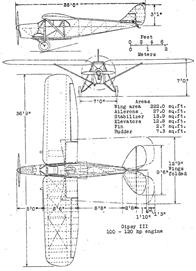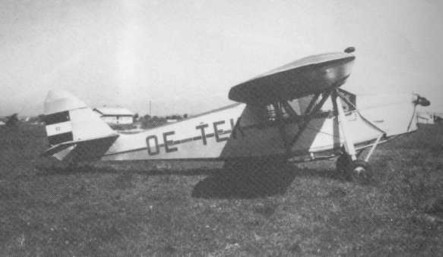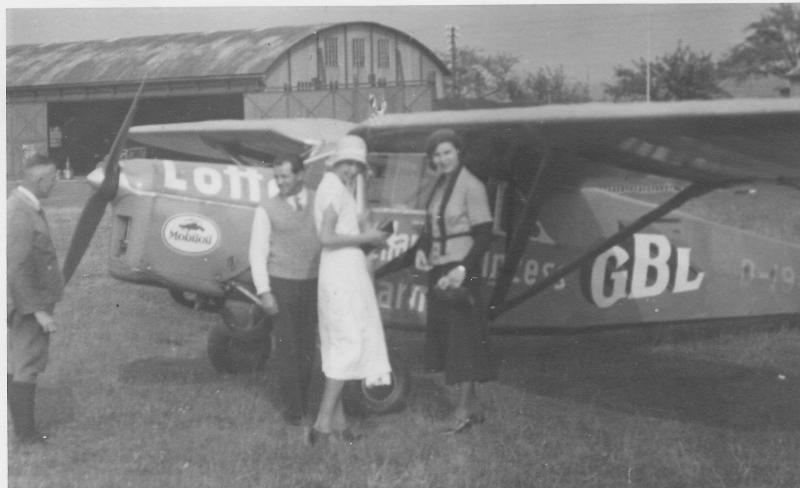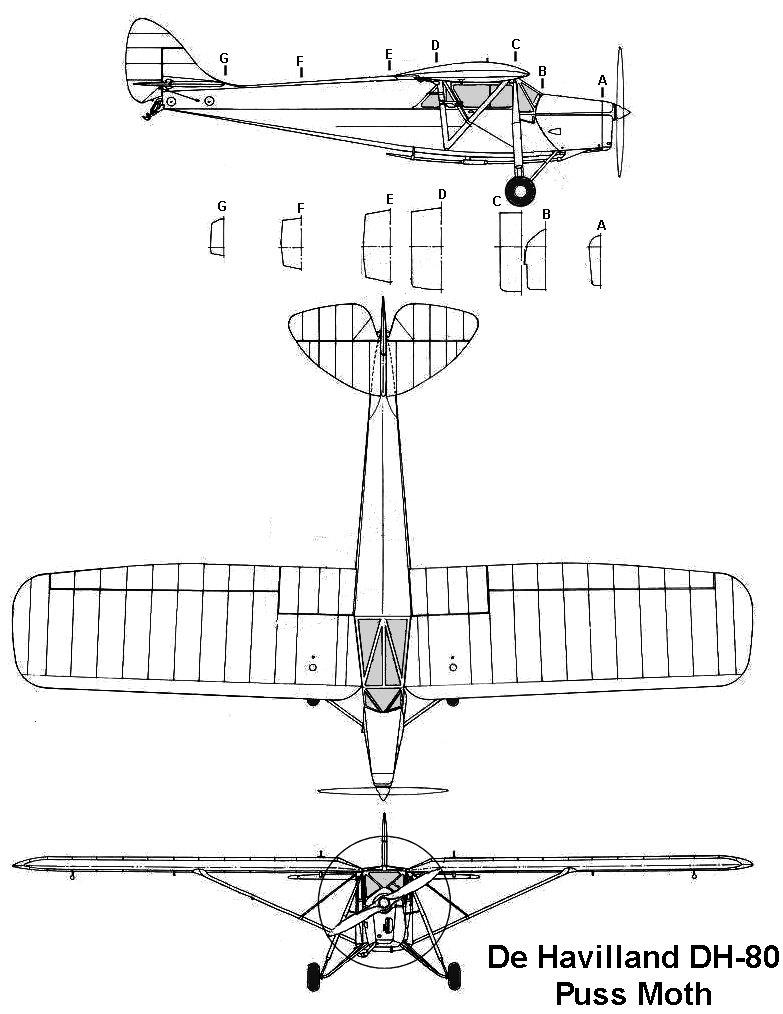D-EDFV : Silver all over
| Type |
1 + 1-2 seat sportplane |
| Engine |
1 de Havilland Gipsy III Propeller: 2-bladed wooden fixed-pitch propeller |
| Dimensions |
Length 7,62 m, height 2,13 m , span 11,2 m , wing area 20,6 m2 , |
| Weights |
Empty 574 kg, loaded 930 kg , max. take off weight |
| Performance |
Max.. speed 206 km/h , cruising speed , range 480 km, endurance , service ceiling 5300 m , climb 3,2 m/sec. |
| Type |
Werk.Nr |
Registration |
History |
|
2069 |
D-1944 |
Bahner-Strumpffabrik/Lichtenstein. Destroyed by fire in August 1932, probably a crash ... |
|
2147 |
G-ABJB, D-EDFV,OK-OFK, OE-TEK, 62 |
Austrian aircraft taken over 1938, OE-TEK and DNr. 62. Owned by Furst Kinsky (President of the Austrian Aero Club) with registration OK-OFK , he sold it to the Luftstreitkräfte 27/5 1935 |
|
2068 |
D-1943, D-EGEQ |
1934. To Haus Bergmann/Dresden |
|
2082 |
D-1948, SP-AEO, D-2220, A-122, OE-DFS |
21.10.1930 To Dr.R.Schulte/Berlin Dec. 1931 A.Friedrich/Berlin . Sold to Poland 9.30 To I.Goldberg/Lwow,Fischer vel Mollard / A. Sold 22.10.31. To Austria 1932 Dr.Fritz Simmer (A-122 ) Rereg .35 OE-DFS |
|
2146 |
D-2030, D-EKYM |
May1931 To F.v.Opel/Russelsheim , to DLV |
|
2227 |
D-2235, D-EPYK |
March 1932 to A.Saulmann/ Erlenhof |
|
2183 |
CH-276, HB-ERA, OK-ATU, OE-AAI, D-EAAI |
28.07.1931 to Dr G Wettstein /Zurich , 28.07.31 to Dr G Wettslein/ Zurich registered 1.35 HB-ERA Sold Czechoslovakia 3.9.35 Bata ,Zlinska letecka AS/Napajedla 10.09.35 . Sold Austria 31.1.38 to Anton Habsburg . Sold Germany 4.39 |
|
|
D-EBAX |
To August Zink/Roth b.Nurnberg |
|
|
D-EDER |
|

The unnamed DH.80 prototype which first flew in September 1929 was designed for the flourishing private flying movement in the United Kingdom. It was a streamlined all-wooden aircraft fitted with the new de Havilland Gipsy III inverted inline engine that gave unimpeded vision across the nose without the protruding cylinder heads of the earlier Gipsy II engine.
After the prototype was tested, the aircraft was redesigned with a fabric-covered steel-tube fuselage and as such redesignated the DH.80A Puss Moth. The first production aircraft flew in March 1930 and was promptly sent on a sales tour of Australia and New Zealand. Orders came quickly, and in the three years of production ending in March 1933, 259 were manufactured in England. An additional 25 aircraft were built by de Havilland Canada. Most were fitted with the 130 hp (97 kW) Gipsy Major engine that gave slightly better performance.
The Puss Moth was replaced on the production line by the de Havilland DH.85 Leopard Moth that, with a plywood fuselage, was both cheaper to build, and lighter weight. Being lighter, the Leopard Moth had better performance on the same rather modest 130 hp (97 kW) Gipsy Major engine
Early in its career, the DH.80A was plagued by a series of fatal crashes, the most famous being to Australian aviator Bert Hinkler while crossing the Alps in CF-APK on 7 January 1933. The cause was eventually pinned down to "flutter" caused by turbulence leading to wing failure – this was corrected by stiffening the front strut with a jury strut to the rear wing root fitting. One aircraft took part in the Challenge 1934 European tourist plane contest, but dropped out because of an engine fault on one of the last stages.
Most DH.80As were used as private aircraft, though many also flew commercially with small air charter firms for passenger and mail carrying. Seating was normally two although in commercial use two passengers could be carried in slightly staggered seats with the rear passenger's legs beside the forward passenger seat. The wings folded backwards for storage, pivoting on the rear spar root fitting and the V-strut root fitting, a system used on other de Havilland light aircraft of the period.
During the early 1930s, DH.80s were used for a number of record breaking flights. In early 1931, Nevill Vintcent made the first flight from England to Ceylon in G-AAXJ. On 25 May 1931 Capt James Douglas Mail flew in his Puss Moth G–ABIU named Baby Tank from Croydon to Bulawayo, taking 8 days according to his logbook via Pisa to Rome then on to north Africa and down the east coast, arriving 8 days later. Total flying time was 73hrs 50mins.
In July and August 1931 Amy Johnson made an eight-day flight with her co-pilot, Jack Humphreys, to Moscow and Tokyo in G-AAZV, named Jason II, completing the leg to Moscow in one day.
Late in 1931, the Australian Bert Hinkler piloted the Canadian-built CF-APK on a series of important flights including New York City to Jamaica, Jamaica to Venezuela, and a 22-hour, west-east crossing of the South Atlantic, only the second solo transatlantic crossing.
In November 1931, the 19-year-old Peggy Salaman set out in G-ABEH named Good Hope, to beat the record for the flight from London to Cape Town. She succeeded in arriving in Cape Town at 5.40 a.m. with Gordon Store, her co-pilot and navigator, beating the previous record set up by Glen Kidston by more than one day.
Most famous of the record breaking Puss Moths was Jim Mollison's G-ABXY, The Heart's Content which completed the first solo east-west Atlantic crossing in August 1932 from Portmarnock Strand near Dublin to New Brunswick, Canada and the first east-west crossing of the South Atlantic from Lympne Aerodrome to Natal, Brazil in February 1933. His wife, Amy Johnson, made record flights between England and Cape Town using G-ACAB, Desert Cloud in 1932. C. J. Melrose flew VH-UQO, named My Hildegarde in the 1934 MacRobertson Air Race. They finished overall seventh and second on handicap in a time of 10 days 16 hours.[5]



